Abstract
OBJECTIVE: To evaluate the use of urinary mercapturic acids as a biomarker of human exposure to allyl chloride (3-chloropropene) (AC). During three regular shut down periods in a production factory for AC, both types of variables were measured in 136 workers involved in maintenance operations. METHODS: Potential airborne exposure to AC was measured by personal air monitoring in the breathing zone. In total 205 workshifts were evaluated. During 99 workshifts no respiratory protection equipment was used. Mercapturic acid metabolites were measured in urinary extracts by gas chromatography-mass spectrometry (GC-MS). RESULTS: During 86 work shifts when no respiratory protection was used the air concentrations of AC were below the Dutch eight hour time weighted average (8 h-TWA) occupational exposure limit (OEL) of AC (3 mg/m3), whereas in 13 workshifts the potential exposure, as measured by personal air monitoring, exceeded the OEL (3.3 to 17 mg/m3). With the aid of GC-MS, 3-hydroxypropylmercapturic acid (HPMA) was identified as a minor and allylmercapturic acid (ALMA) as a major metabolite of AC in urine samples from the maintenance workers exposed to AC. The concentrations of ALMA excreted were in a range from < 25 micrograms/l (detection limit) to 3550 micrograms/l. The increases in urinary ALMA concentrations during the workshifts correlated well with the 8h-TWA air concentrations of AC (r = 0.816, P = 0.0001, n = 39). Based on this correlation, for AC a biological exposure index (BEI) of 352 micrograms ALMA/g creatinine during an eight hour workshift is proposed. In some urine samples unexpectedly high concentrations of ALMA were found. Some of these could definitely be attributed to dermal exposure to AC. In other cases garlic consumption was identified as a confounding factor. CONCLUSION: The mercapturic acid ALMA was identified in urine of workers occupationally exposed to airborne AC and the increase in ALMA concentrations in urine during a workshift correlated well with the 8 h-TWA exposure to AC. Garlic consumption, but not smoking, is a potential confounding factor for this biomarker of human exposure to AC.
Full text
PDF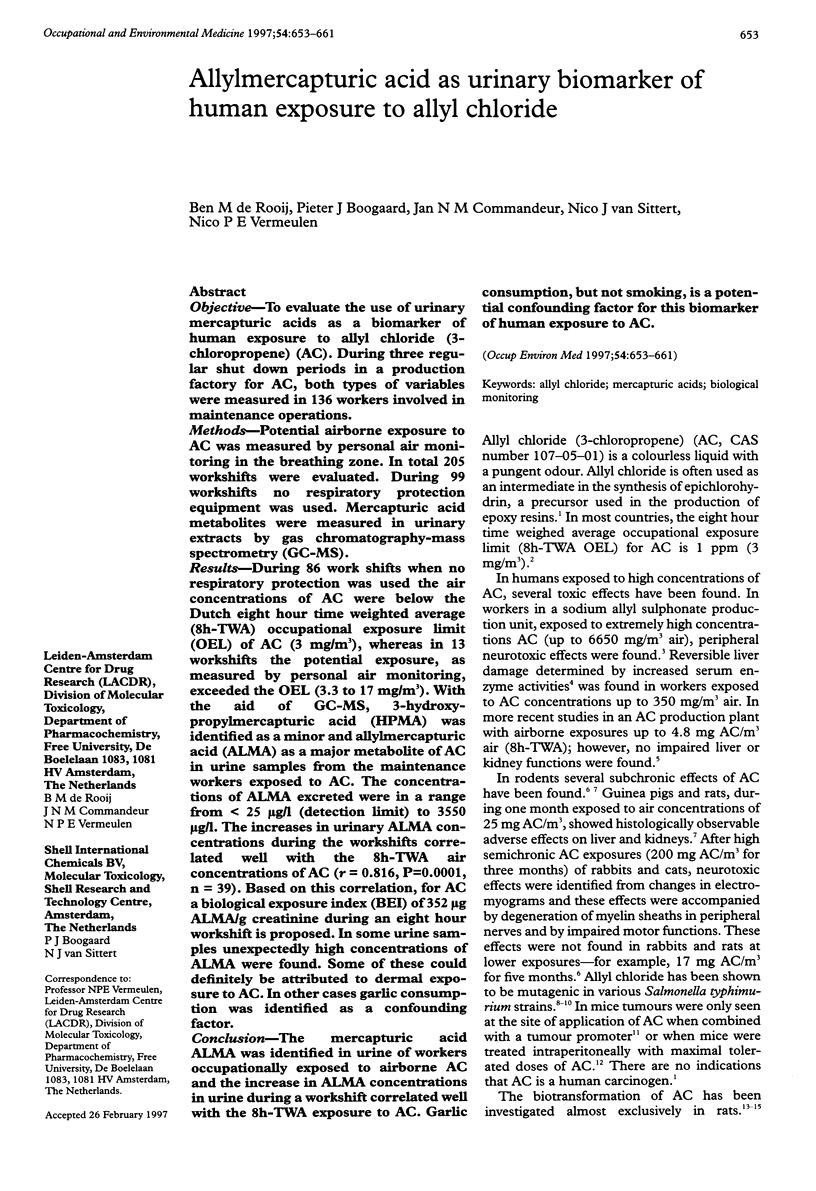
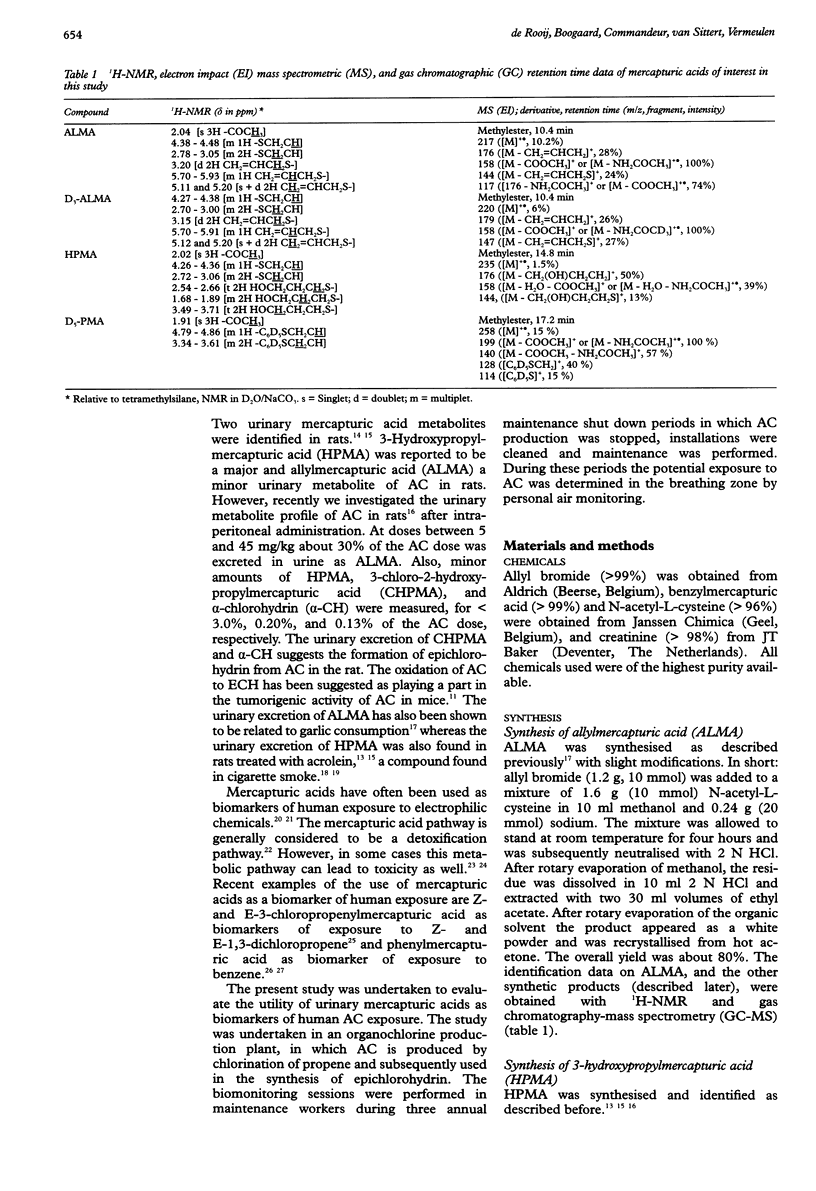
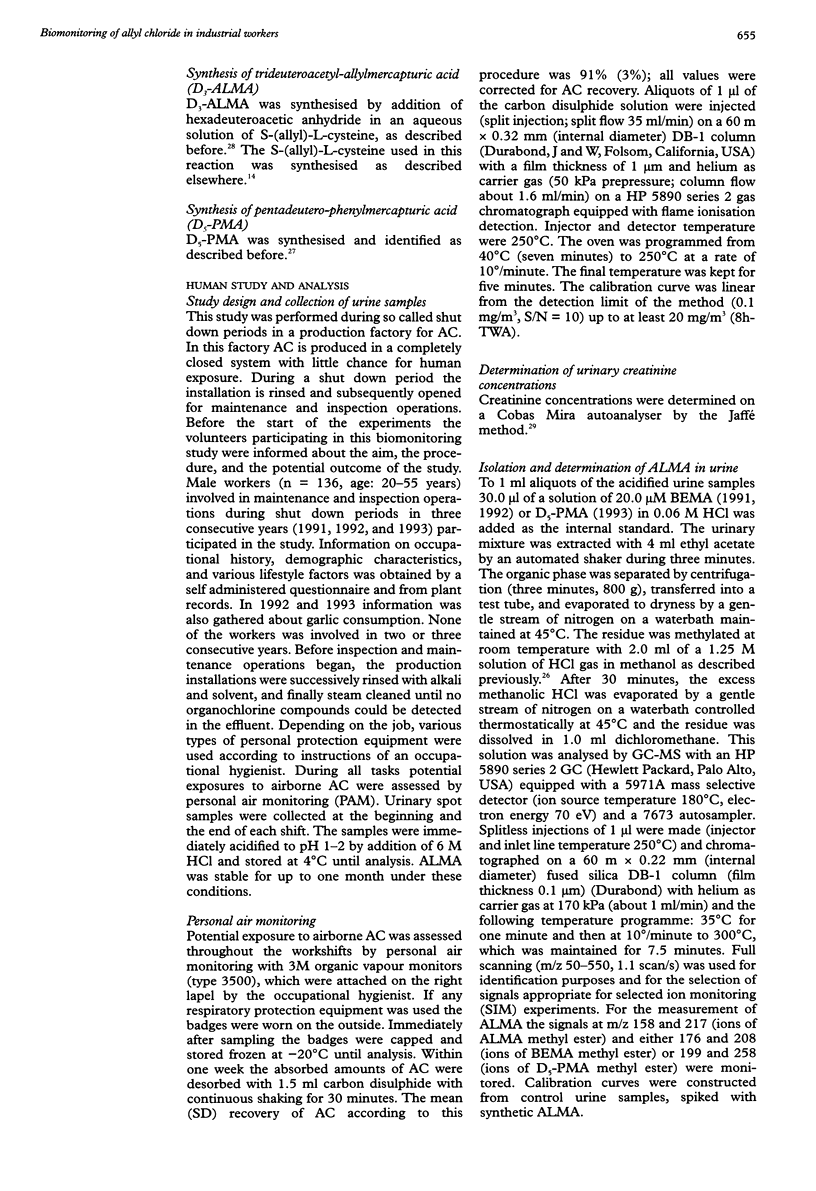
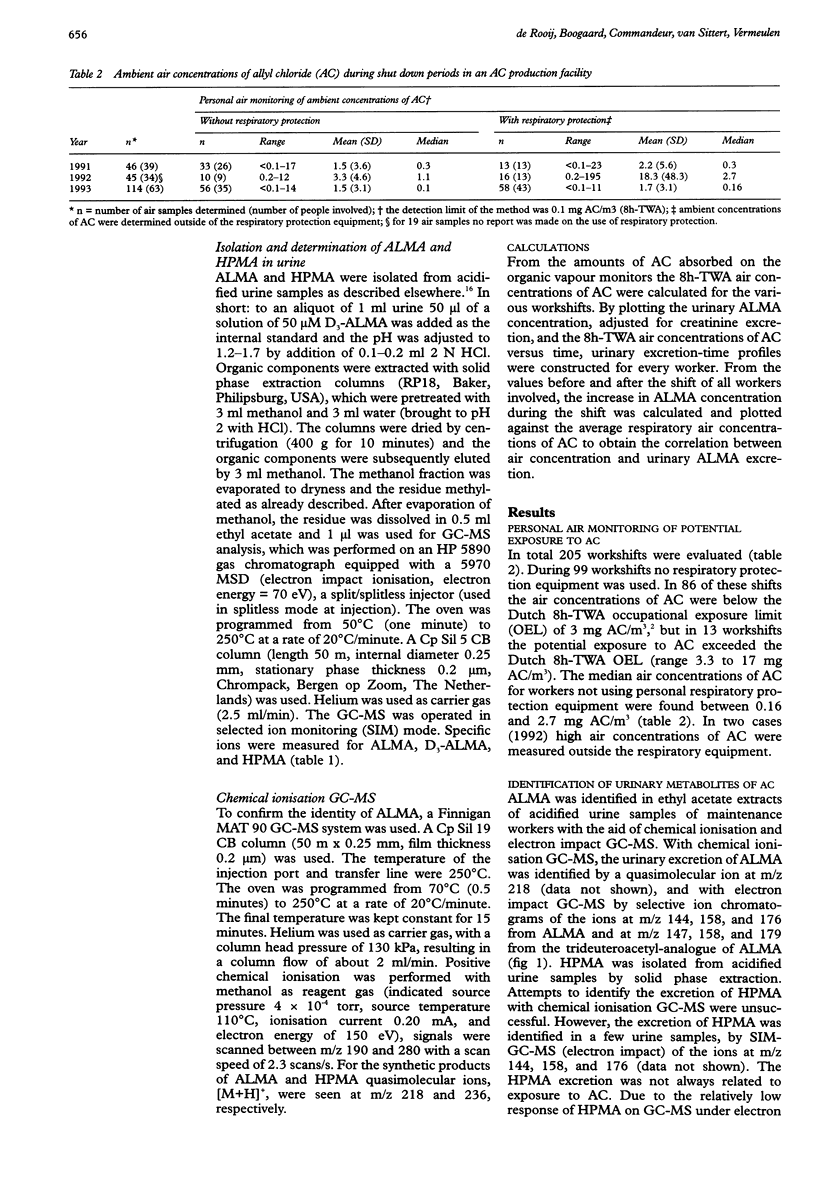
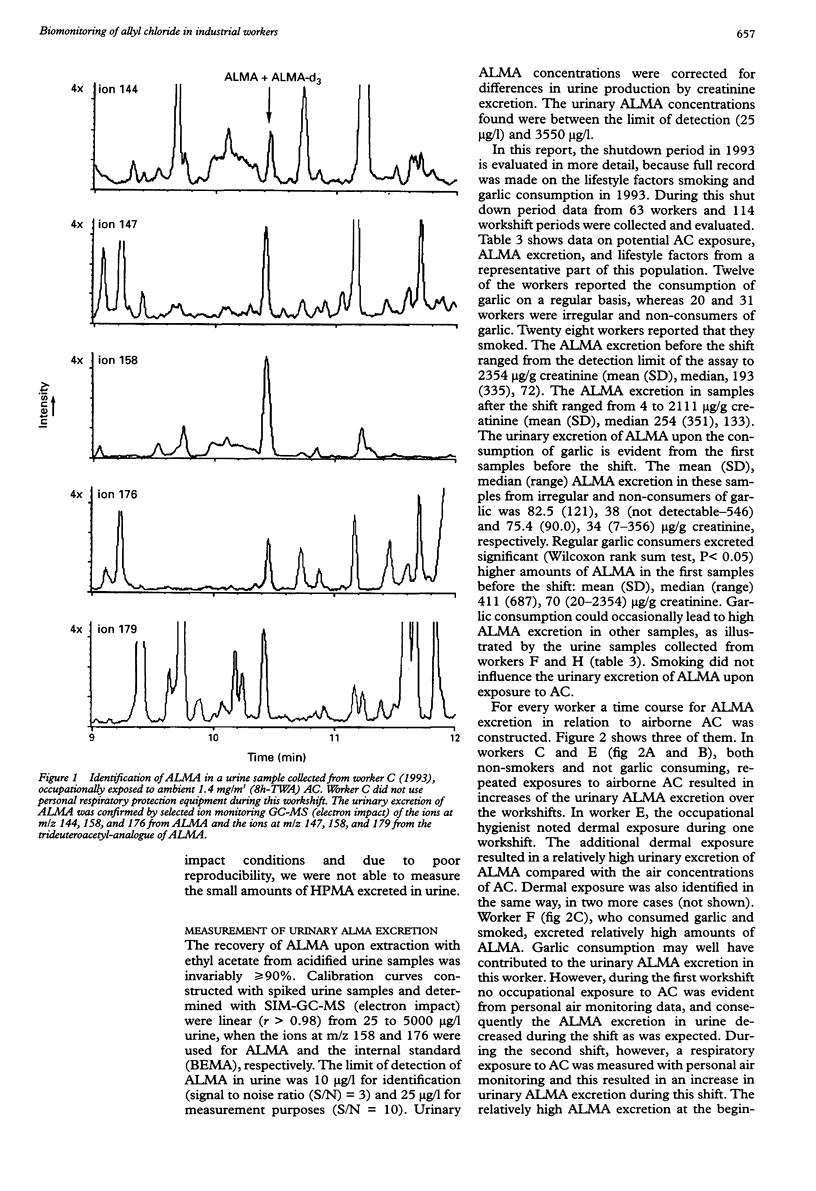
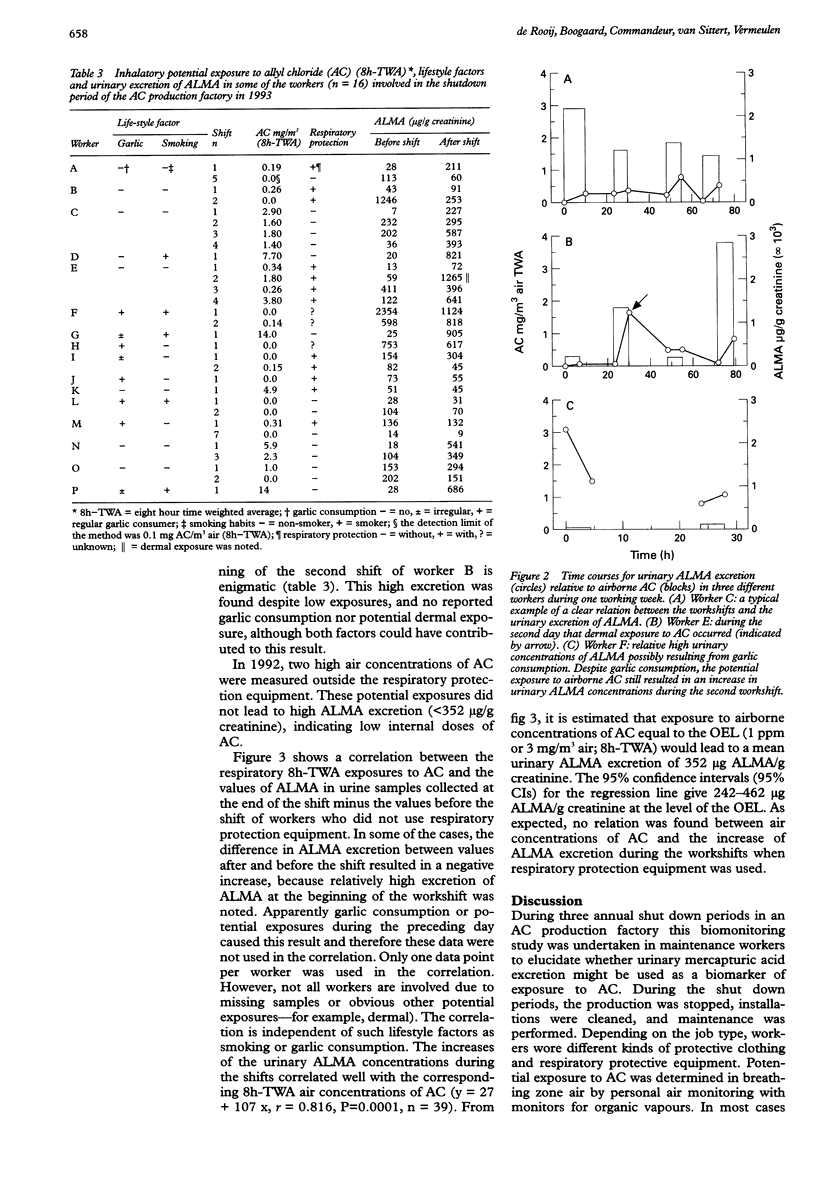
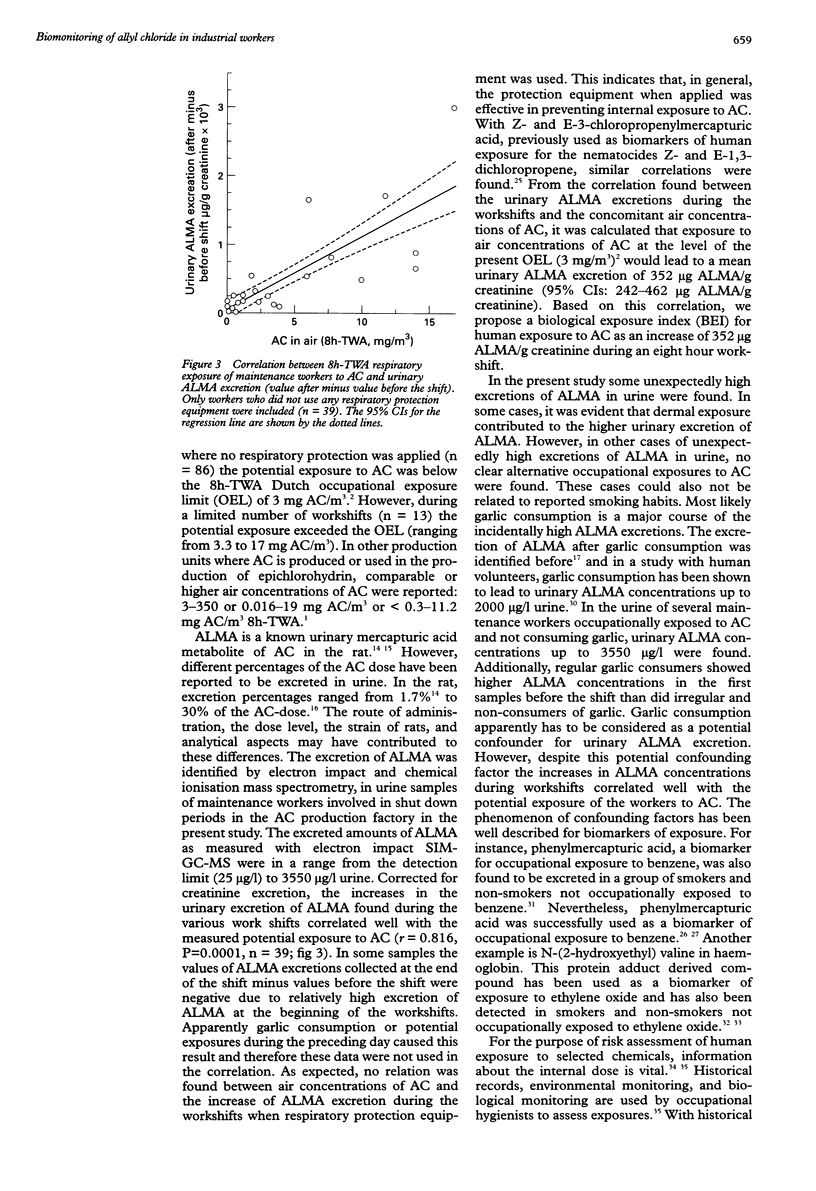
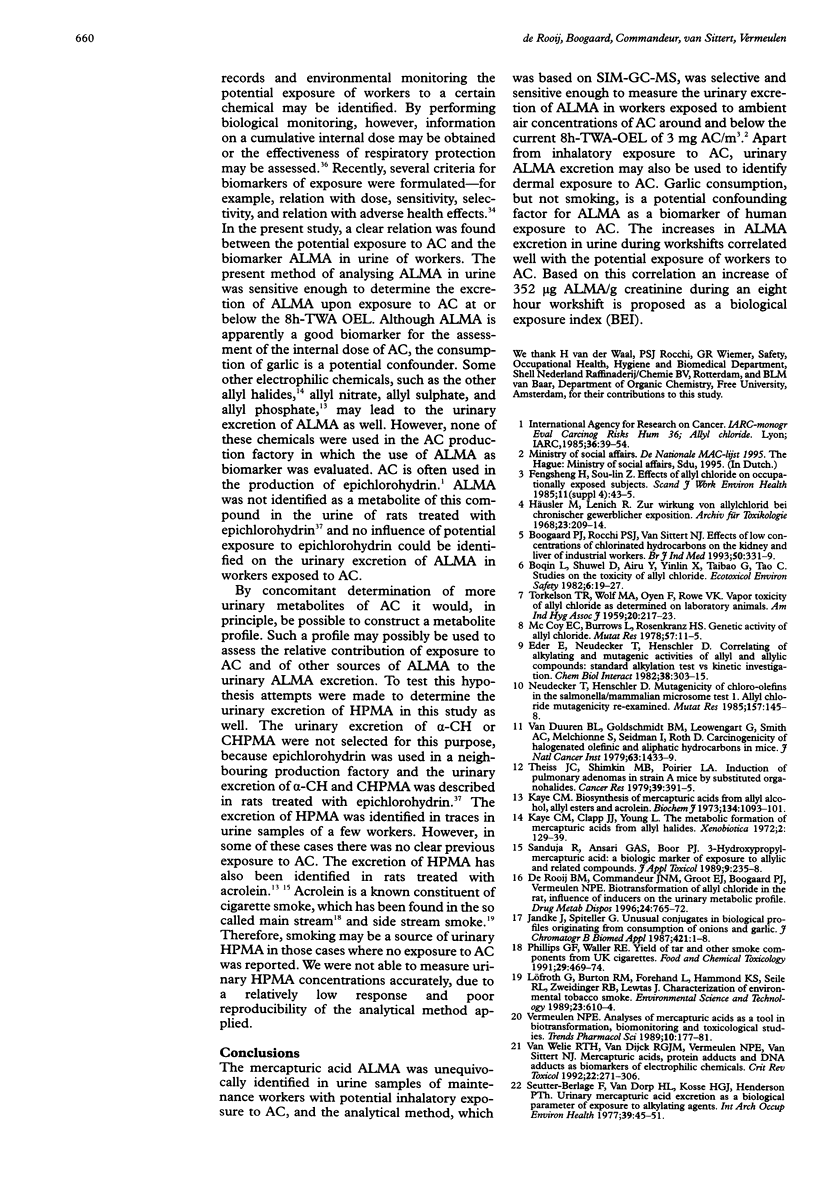
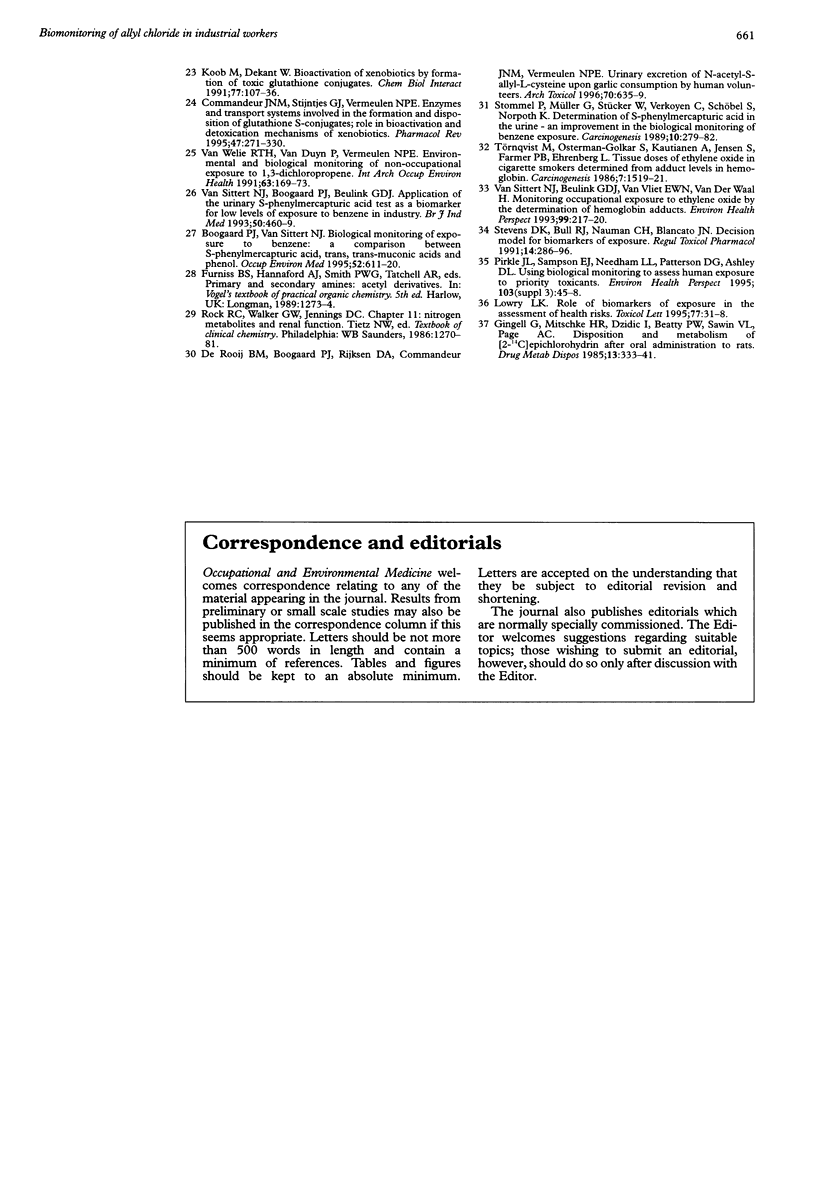
Selected References
These references are in PubMed. This may not be the complete list of references from this article.
- Boogaard P. J., Rocchi P. S., van Sittert N. J. Effects of exposure to low concentrations of chlorinated hydrocarbons on the kidney and liver of industrial workers. Br J Ind Med. 1993 Apr;50(4):331–339. doi: 10.1136/oem.50.4.331. [DOI] [PMC free article] [PubMed] [Google Scholar]
- Boogaard P. J., van Sittert N. J. Biological monitoring of exposure to benzene: a comparison between S-phenylmercapturic acid, trans,trans-muconic acid, and phenol. Occup Environ Med. 1995 Sep;52(9):611–620. doi: 10.1136/oem.52.9.611. [DOI] [PMC free article] [PubMed] [Google Scholar]
- Commandeur J. N., Stijntjes G. J., Vermeulen N. P. Enzymes and transport systems involved in the formation and disposition of glutathione S-conjugates. Role in bioactivation and detoxication mechanisms of xenobiotics. Pharmacol Rev. 1995 Jun;47(2):271–330. [PubMed] [Google Scholar]
- Eder E., Neudecker T., Lutz D., Henschler D. Correlation of alkylating and mutagenic activities of allyl and allylic compounds: standard alkylation test vs. kinetic investigation. Chem Biol Interact. 1982 Feb;38(3):303–315. doi: 10.1016/0009-2797(82)90060-6. [DOI] [PubMed] [Google Scholar]
- Gingell R., Mitschke H. R., Dzidic I., Beatty P. W., Sawin V. L., Page A. C. Disposition and metabolism of [2-14C]epichlorohydrin after oral administration to rats. Drug Metab Dispos. 1985 May-Jun;13(3):333–341. [PubMed] [Google Scholar]
- He F. S., Zhang S. L. Effects of allyl chloride on occupationally exposed subjects. Scand J Work Environ Health. 1985;11 (Suppl 4):43–45. [PubMed] [Google Scholar]
- Häusler M., Lenich R. Zur Wirkung von Allylchlorid bei chronischer gewerblicher Exposition. Arch Toxikol. 1968;23(3):209–214. [PubMed] [Google Scholar]
- Jandke J., Spiteller G. Unusual conjugates in biological profiles originating from consumption of onions and garlic. J Chromatogr. 1987 Oct 9;421(1):1–8. doi: 10.1016/0378-4347(87)80373-0. [DOI] [PubMed] [Google Scholar]
- Kaye C. M. Biosynthesis of mercapturic acids from allyl alcohol, allyl esters and acrolein. Biochem J. 1973 Aug;134(4):1093–1101. doi: 10.1042/bj1341093. [DOI] [PMC free article] [PubMed] [Google Scholar]
- Kaye C. M., Clapp J. J., Young L. The metabolic formation of mercapturic acids from allyl halides. Xenobiotica. 1972 Mar;2(2):129–139. doi: 10.3109/00498257209111044. [DOI] [PubMed] [Google Scholar]
- Koob M., Dekant W. Bioactivation of xenobiotics by formation of toxic glutathione conjugates. Chem Biol Interact. 1991;77(2):107–136. doi: 10.1016/0009-2797(91)90068-i. [DOI] [PubMed] [Google Scholar]
- Lowry L. K. Role of biomarkers of exposure in the assessment of health risks. Toxicol Lett. 1995 May;77(1-3):31–38. doi: 10.1016/0378-4274(95)03268-1. [DOI] [PubMed] [Google Scholar]
- Lu B. Q., Dong S. W., Yu A. R., Xian Y. L., Geng T. B., Chui T. Studies on the toxicity of allyl chloride. Ecotoxicol Environ Saf. 1982 Feb;6(1):19–27. doi: 10.1016/0147-6513(82)90076-8. [DOI] [PubMed] [Google Scholar]
- McCoy E. C., Burrows L., Rosenkranz H. S. Genetic activity of allyl chloride. Mutat Res. 1978 Mar;57(1):11–15. [PubMed] [Google Scholar]
- Neudecker T., Henschler D. Mutagenicity of chloro-olefins in the Salmonella/mammalian microsome test. I. Allyl chloride mutagenicity re-examined. Mutat Res. 1985 Aug-Sep;157(2-3):145–148. doi: 10.1016/0165-1218(85)90109-0. [DOI] [PubMed] [Google Scholar]
- Phillips G. F., Waller R. E. Yields of tar and other smoke components from UK cigarettes. Food Chem Toxicol. 1991 Jul;29(7):469–474. doi: 10.1016/0278-6915(91)90093-m. [DOI] [PubMed] [Google Scholar]
- Pirkle J. L., Sampson E. J., Needham L. L., Patterson D. G., Ashley D. L. Using biological monitoring to assess human exposure to priority toxicants. Environ Health Perspect. 1995 Apr;103 (Suppl 3):45–48. doi: 10.1289/ehp.95103s345. [DOI] [PMC free article] [PubMed] [Google Scholar]
- Sanduja R., Ansari G. A., Boor P. J. 3-Hydroxypropylmercapturic acid: a biologic marker of exposure to allylic and related compounds. J Appl Toxicol. 1989 Aug;9(4):235–238. doi: 10.1002/jat.2550090406. [DOI] [PubMed] [Google Scholar]
- Seutter-Berlage F., van Dorp H. L., Kosse H. G., Henderson P. T. Urinary mercapturic acid excretion as a biological parameter of exposure to alkylating agents. Int Arch Occup Environ Health. 1977 Apr 15;39(1):45–51. doi: 10.1007/BF00381551. [DOI] [PubMed] [Google Scholar]
- Stevens D. K., Bull R. J., Nauman C. H., Blancato J. N. Decision model for biomarkers of exposure. Regul Toxicol Pharmacol. 1991 Dec;14(3):286–296. doi: 10.1016/0273-2300(91)90031-p. [DOI] [PubMed] [Google Scholar]
- Stommel P., Müller G., Stücker W., Verkoyen C., Schöbel S., Norpoth K. Determination of S-phenylmercapturic acid in the urine--an improvement in the biological monitoring of benzene exposure. Carcinogenesis. 1989 Feb;10(2):279–282. doi: 10.1093/carcin/10.2.279. [DOI] [PubMed] [Google Scholar]
- TORKELSON T. R., WOLF M. A., OYEN F., ROWE V. K. Vapor toxicity of allyl chloride as determined on laboratory animals. Am Ind Hyg Assoc J. 1959 Jun;20(3):217–223. doi: 10.1080/00028895909343700. [DOI] [PubMed] [Google Scholar]
- Theiss J. C., Shimkin M. B., Poirier L. A. Induction of pulmonary adenomas in strain A mice by substituted organohalides. Cancer Res. 1979 Feb;39(2 Pt 1):391–395. [PubMed] [Google Scholar]
- Törnqvist M., Osterman-Golkar S., Kautiainen A., Jensen S., Farmer P. B., Ehrenberg L. Tissue doses of ethylene oxide in cigarette smokers determined from adduct levels in hemoglobin. Carcinogenesis. 1986 Sep;7(9):1519–1521. doi: 10.1093/carcin/7.9.1519. [DOI] [PubMed] [Google Scholar]
- Van Duuren B. L., Goldschmidt B. M., Loewengart G., Smith A. C., Melchionne S., Seldman I., Roth D. Carcinogenicity of halogenated olefinic and aliphatic hydrocarbons in mice. J Natl Cancer Inst. 1979 Dec;63(6):1433–1439. [PubMed] [Google Scholar]
- Vermeulen N. P. Analysis of mercapturic acids as a tool in biotransformation, biomonitoring and toxicological studies. Trends Pharmacol Sci. 1989 May;10(5):177–181. doi: 10.1016/0165-6147(89)90232-0. [DOI] [PubMed] [Google Scholar]
- de Rooij B. M., Boogaard P. J., Rijksen D. A., Commandeur J. N., Vermeulen N. P. Urinary excretion of N-acetyl-S-allyl-L-cysteine upon garlic consumption by human volunteers. Arch Toxicol. 1996;70(10):635–639. doi: 10.1007/s002040050322. [DOI] [PubMed] [Google Scholar]
- de Rooij B. M., Commandeur J. N., Groot E. J., Boogaard P. J., Vermeulen N. P. Biotransformation of allyl chloride in the rat. Influence of inducers on the urinary metabolic profile. Drug Metab Dispos. 1996 Jul;24(7):765–772. [PubMed] [Google Scholar]
- van Sittert N. J., Beulink G. D., van Vliet E. W., van der Waal H. Monitoring occupational exposure to ethylene oxide by the determination of hemoglobin adducts. Environ Health Perspect. 1993 Mar;99:217–220. doi: 10.1289/ehp.9399217. [DOI] [PMC free article] [PubMed] [Google Scholar]
- van Sittert N. J., Boogaard P. J., Beulink G. D. Application of the urinary S-phenylmercapturic acid test as a biomarker for low levels of exposure to benzene in industry. Br J Ind Med. 1993 May;50(5):460–469. doi: 10.1136/oem.50.5.460. [DOI] [PMC free article] [PubMed] [Google Scholar]
- van Welie R. T., van Dijck R. G., Vermeulen N. P., van Sittert N. J. Mercapturic acids, protein adducts, and DNA adducts as biomarkers of electrophilic chemicals. Crit Rev Toxicol. 1992;22(5-6):271–306. doi: 10.3109/10408449209146310. [DOI] [PubMed] [Google Scholar]
- van Welie R. T., van Duyn P., Vermeulen N. P. Environmental and biological monitoring of non-occupational exposure to 1,3-dichloropropene. Int Arch Occup Environ Health. 1991;63(3):169–173. doi: 10.1007/BF00381564. [DOI] [PubMed] [Google Scholar]


